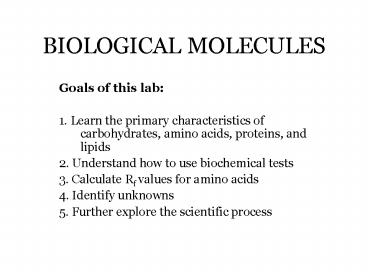BIOLOGICAL MOLECULES - PowerPoint PPT Presentation
1 / 16
Title:
BIOLOGICAL MOLECULES
Description:
5. Further explore the scientific process. CARBOHYDRATES ... Examples: starch, dextrin, glycogen, cellulose, chitin, inulin. PROTEINS. Made up of amino acids ... – PowerPoint PPT presentation
Number of Views:488
Avg rating:3.0/5.0
Title: BIOLOGICAL MOLECULES
1
BIOLOGICAL MOLECULES
- Goals of this lab
- 1. Learn the primary characteristics of
carbohydrates, amino acids, proteins, and lipids - 2. Understand how to use biochemical tests
- 3. Calculate Rf values for amino acids
- 4. Identify unknowns
- 5. Further explore the scientific process
2
CARBOHYDRATES (SACCHARIDES)
Formula Cn(H2O)n or (CH2O)n
Functions?
Monosaccharides
Characteristics?
Common examples?
Oligosaccharides
Functions?
Polysaccharides
3
MONOSACCHARIDES
- Simple sugars
- Formula C6H12O6
- The monomers that make up more complex carbs
4
OLIGOSACCHARIDES
- Polymers of two to ten monosaccharides
- Simplest are disaccharides
- Held together by a glycosidic bond (formed by
dehydration synthesis) - Examples sucrose (in cane and beet sugar),
maltose (in malt sugar), and lactose (in
mammalian milk sugar)
5
POLYSACCHARIDES
- More than 10 monosaccharides
- Form linear or branched chains
- Examples starch, dextrin, glycogen, cellulose,
chitin, inulin
6
PROTEINS
- Made up of amino acids
- Amino acids have an amine group (-NH2), a
carboxyl group (-COOH), a hydrogen, and a side
group (R-group) - The R-group determines the differences between
amino acids - Synthesized by condensation reactions to form
polypeptide chains---write the reaction! (Page55) - Held together by peptide bonds---draw the peptide
bond! (Page55)
- Examples
- Enzymes
- Storage proteins
- Structural proteins
- Protective proteins
- Transport proteins
- Hormones
- Toxins
7
How to tell an amino acid is a polar or nonpolar
amino acid?
8
FATS
- Also called triglycerides
- Consist of three fatty acids attached to glycerol
- Held together by ester linkages
- Are either saturated or unsaturated
9
Chromatography (I)
Filter paper
Organic phase---migrate faster
solvent
aqueous phase---migrate slower
In a given period of time, the distance of an aa.
travels depends on its affinity to the two phases
of the solvent
Greater affinity to organic phase---travel longer
distance
Greater affinity to aqueous phase---travel
shorter distance
10
Chromatography (II)
What determines the affinity of an aa. to the two
phases?
------ R group
Hydrophobic aa
Hydrophilic aa
Higher affinity to aqueous phase
Higher affinity to organic phase
Travel lesser distance
Travel greater distance
- What about a polar/nonpolar aa?
- What is the expected result for two different
polar aa.?---can you see any difference? If yes,
what makes them different?
11
Calculating Rf
- Rf distance amino acid migrated from point of
origin/ distance solvent front migrated from the
point of origin - Functions in differentiating one amino acid from
another
12
Difference between Biuret test and Bradford
test---purpose?
13
Results
Unknown 1 linear polysaccharide Unknown 2
monosaccharide Unknown 3 protein fat Unknown
4 monosaccharide protein Unknown 5
monosaccharide
14
(No Transcript)
15
Why do you need known samples when performing
biochemical tests?
Known samples Controls
Positive control---yield expected positive result
Negative control---yield expected negative result
Positive control tells you the negative test
result for the unknown sample is true negative
not because the test dose not work
Negative control tells you the positive test
result for the unknown sample is true positive
not because the specificity of the test is bad
16
For every experiment, should ask why, how and what
Making conclusion
Why---why do the experiment, or, what is the
purpose of the experiment? How---How to carry out
the experiment, or, what is the experimental
design?---biochemical test, positive control,
negative control, experimental group What---what
is the result? Conclusion for the experiment































